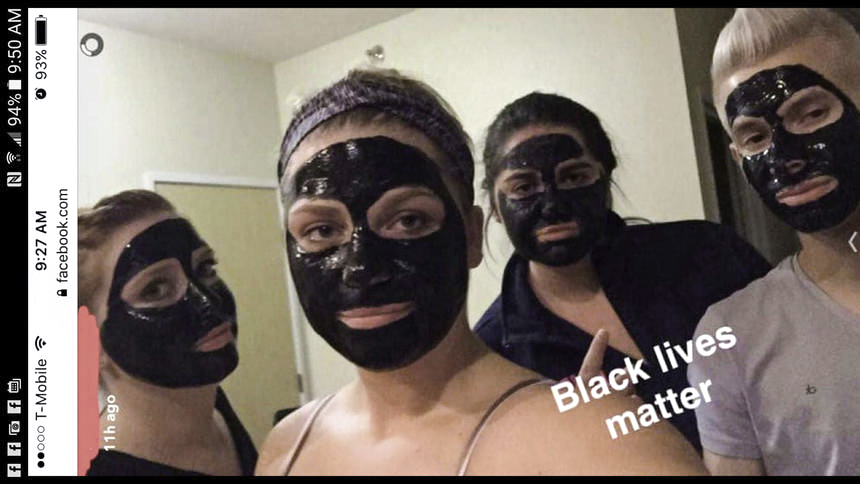One year later
UND and Snapchat controversy
In a September 2016 photo that circulated on social media platforms, UND students posed in black charcoal masks with the caption “Black lives matter.”
February 26, 2018
Are students to blame for misconduct, or is an institution to blame for refusing punishment?
In fall 2016, social media was the focus of the University of North Dakota after two racist incidents occurred on Snapchat.
The first was when a group of white students took a black female student’s phone and had, without her knowledge, posted a picture with the caption “locked the black bitch out.” The picture had been posted using the black student’s Snapchat account. According to the student, she was unaware of the picture until her friends had told her well after its posting.
In the following days, various students of color and student organizations held a “Zero Tolerance Rally” outside Twamley Hall, with attendees including President Mark Kennedy.
The second occurrence involved another Snapchat picture with a group of white students wearing black faces with the caption “Black Lives Matter.” This time, it was with their own phones.
None of the students involved in either of the posts were punished.
Kennedy wrote in a university-wide email that he wanted to seek a proper response without infringing on the First Amendment rights of the students.
“The challenge we all face is to find the balance between wanting to eliminate expressions of racism and bigotry and supporting the free speech guaranteed by the First Amendment,” Kennedy wrote after the second occurrence.
According to the UND Code for Student Living, “A student is expected to show, both within and outside of the University, respect for law and order, personal honor, and the rights of others. To further strengthen the sense of community at the University of North Dakota, we affirm the following: (1) That everyone be allowed to work, learn, and live in a safe, caring environment; (2) That everyone learn about, understand, appreciate, and respect varied cultures; (3) That everyone matters; (4) That all individuals be respected and treated with dignity and civility; (5) That everyone continue to share in the responsibility of making UND a better place.”
It goes on to say that students are “subject to civil law and civil authority.”
Riley Hallaway, a UND communications student, produced a documentary, “The Atmosphere,” on the original Snapchat picture and its effects on campus. In it, the student whose phone was taken said she stopped going to classes and her grades slipped after the incident.
There is no prong of the Code’s test that passes. And yet, the university still felt that there was nothing, under their own jurisdiction, they could do.
In regards to these actions being unpunishable under the Constitution, it isn’t uncommon for universities to punish and or expel students who post racist content on their own personal social media accounts.
According to the New York Post, a University of Alabama student was expelled in January after posting a racist rant that frequently featured the N-word.
According to The Harvard Crimson, Harvard rescinded admissions to 10 incoming freshman after a private group chat featured students posting racist and vulgar memes.
In March 2015, a video of a University of Oklahoma fraternity singing a song that featured the N-word surfaced. The fraternity was kicked off campus and two students were expelled.
These stories, as well as the two from UND, were covered on local and national news platforms. According to students in “The Atmosphere,” these are rarely one-time occurrences. Non-white students can be regularly subjected to racist conduct both online and on-campus.
Meaning, if the university wants a difference in racial conduct on-campus, the Code of Student Life will need to be legitimized.


